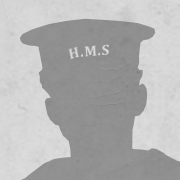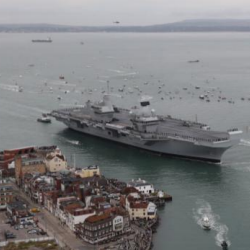
Albert William Garland Symonds

Portsmouth
Port Detail
Next of kin address Anne England More info Enlisted 02/07/1906. Southampton 1st Wtr 28/10/15 - 14/02/17. Victory 2-2 (MOB) 05/10/1938 to pension. Marriage 1913 Q3 Anne Causley in Portsmouth Petty Officer Writer Albert Symonds served on HMS Southampton (a town class Light Cruiser) at the Battle of Jutland. One of seven children he was educated at the Royal Hospital School Greenwich and served in the Royal Navy for 25 years, retiring as a Chief Writer His Journal, which he began on return to Rosyth on the 2nd of June, has been made available by his granddaughter Sarah Pilbeam of Widley. Southampton was assisgned to the 1st Battle Squadron becoming the flagship of the 1st Light Cruiser Squadron. She had an extremely active wartime career, participating in the Battle of Heligoland Bight on 28th August 1914, the Battle of Dogger Bank on 24th January 1915 and the Battle of Jutland as the 2nd Light Cruiser Squadron flagship with Commodore Goodenough embarked. The battle was fought over 36 hours during 31st may and 1st June 1916. Tuesday 30th May at Rosyth. 6 p.m. – signal from Flag Lion to B.C.F (Battle Cruiser Fleet) and 5th B.S. (Battle Squadron) – raise steam and report when ready to proceed. 9 p.m. – weighed and proceeded. Nobody knowing what the object of the operation is. Wednesday 31st May at sea. We cruised East at no great speed all forenoon, we had steam for full power at half an hour’s notice. The course of the fleet was Easterly, with the L.C (Light Cruiser) screen spread from North to South, with ourselves to the South. 2.23 p.m. – Galatea reports sighting two enemy Light Cruisers and much smoke bearing east. 2.56 p.m. – they reported the German B.C. Fleet. We maintained our Easterly course. 3.55 p.m. – the Battle Cruisers form into line, steering south with Lion in the lead. They at once opened fire on the German B. C. Fleet. We were stationed on the Lion’s Starboard bow with a number of T.B.D’s (Torpedo Boat Destroyers) and the Light Cruiser Champion. As soon as we opened fire (and by “we” I mean our B.C), the Germans opened fire as well, if not before. We were only about a mile from or so from us with the Germans about 20,000 yards away against a very dark background, whilst we were silhouetted against the Western sky, and at a tactical disadvantage. It was very difficult for the B.C’s to see the German B.C’s. 4.15 p.m. (approx.) – I was watching the line, observing Lion appear from a huge fountain of water when I was horrified to see a colossal column of grey white smoke stand on the water where “Indefatigable” had been. This column of smoke which I estimated was 700 feet high expanded on top into a great mushroom; the base of the stalk became a fiery red. I realised that “Indefatigable” he been blown up, with the following ship passing through the place where she had been. I cannot attempt to describe my feelings as the action continued as before. 4.23 p.m. – in an almost similar manner the “Queen Mary” was obliterated by an 800 feet high mushroom of fiery smoke, in this case I remember seeing bits of her ‘flying upward’. As is watched this fiery gravestone, it seemed to waver slightly at the base and I caught a momentary but clear glimpse of the hull of the “Queen Mary” sticking out of the water from the stern to the after funnel. I noticed now that we were about half a mile a head of the “Lion” and observed the shell or shells that hit her putting the midship port turret out of action and causing a fire. (I heard this single shell accounted for the greater number of the 109 killed on her). 4.38 p.m. – We sighted and reported Light Cruisers followed by the German High Seas Fleet bearing South East, steering about North East or North. Either at this time or just before Admiral Beatty made the signal to alter course 16 points (180 degrees) which the B.C. did. We held on towards the South, as we thought we might be able to carry a torpedo attack or to be able to make a more accurate enemy report. The range closed to 12,900 yards; however, we were unable to get into a position to fire the torpedoes, so we turned towards the north. 4.45 p.m. – we now had the German B.C on our starboard bow and the German Battle Fleet on our starboard quarter and abeam. We could not see much of the engagement until the 5th B. S engaged the leading half of the German line. We were close to the last ship of the 5th B. S. at about 4-6 cables on its disengaged quarter, whilst at other times almost astern. Away on our port quarter were some destroyers and other ships of the squadron. 5 p.m. – 6 p.m. I I can truthfully say I though each succeeding minute was our last. For that hour we were under persistent 11 inch shellfire from the rear of the German Fleet. That is to say, all the German battleships which could not get to our battleships thought they might as well while away the time by knocking us out needless to say we could not fire a shot in return as the range was about 16,000 yards, way beyond our guns. ‘I crouched behind the 1/10 inch plate of the after control with Hayward-Booth (the Sub) and the Clerk and we gnawed on bully beef. However, my throat was so dry that I could not get much down and we could not get any water. Within a minute or two a series of ear splitting reports indicated that another salvo had burst around the ship. Against my will I could never resist hanging over the edge and then is saw half a dozen or four muddy foamy looking circles in the water over which black smoke hung. Sometime these poos were one side, sometimes the other. Some were literally absolutely alongside the ship and those threw masses of water onboard drenching us to the skin. I should say (and this is a carefully reasoned and considered estimate) that 40 large shells fell within 75 yards of us within the hour and many others at varying distances out. We seemed to bear a charmed life but it was obvious that such a position could not last forever. How we escaped for an hour amazes everyone from the Commander downwards but providence was with us. 6.17 p.m. – Sir John Jellicoe with the Battle Fleet arrived, causing the action to enter a 3rd phase. I must emphasise that both the 1st and 2nd phases of the action, in both of these an important factor was that conditions were much in favour of the Germans through our relative positions and the time of day. Though at 4 p.m. the sun was still high in the heavens it was to the N. W of us and we were to the West of the enemy. As this wonderful afternoon drew on and the sun sank lower towards the N.W. horizon the British ships were silhouetted against the illumination in the sky. The enemy showed up indifferently against a mass of low lying dark grey and purplish clouds. Having stated this most important point I can now describe how at 6.17 p.m. I heard with the keenest satisfaction that Sir John Jellicoe who had been hurrying South with the Grand Fleet Battleships and armoured cruisers had been sighted right ahead. It is neither my place nor my province to discuss in a descriptive account such as this, the tactics employed on the 31st May – 1st June. But I cannot allow myself to go any further without expressing my admiration and delight at the masterly gunnery in which the Commander-in-Chief worked round the Germans to get good light, by putting them to the Westward of him. When one considers that he could not be considered as fully prepared for the General Fleet Action and that he had been obliged to come rushing South to get us out of a hot corner his success is still more magnificent. When the Battle Fleet deployed to the Eastward our B.C. passing across the bows of the Fleet took up their position in the van where also to be found the 1st, 4th and 3rd L.C.S. and destroyers. The 5th B.S. joined up quite naturally at the tail of the line and we remained astern of them with the “Faulknor” and her destroyers. As the Grand Fleet deployed I saw a terrible sight. I saw a four funnelled Cruiser apparently steering down between the two Battle lines, she was moving surrounded by splashes and was in hell. 6.25 p.m. – that terribly familiar column of smoke rose over the spot where I had last seen her. It was the end of the “Defence” (armoured Cruiser). From amidst the welter of confusion a second 4 funnelled cruiser appeared steering about West at 7 knots; she was heavily on fire aft and seemed in a bad way. Painfully she crept across the end of our Battle Line and drew clear of the inferno which was still lashing the water where the “Defence” had gone down. After we had seen the “Defence” go down and as the “Warrior” hauled across out of it, the line of battle became formed and action became general. Shortly afterwards we were amazed to see “Warspite” suddenly turn to starboard and steer towards the German fleet. I guessed at once she had been hit in the steering gear. For three or four thousands yards she went towards them coming under a hail of huge shells as the German Battle Fleet or rather portions of it concentrated on her. I was prepared to see her go up at any moment as it did not seem possible she could survive. We were astonished to see her re-appear again from amongst the cascades of splashes and smoke around her and steaming strongly came up to the rear of the fleet again. She was shortly afterwards ordered to return to Rosyth for repairs. 6.47 p.m. – we observed a 3 funnelled German Battleship lying between the tail of our line and the German line, she was stopped and on fire. Having nothing particular at the moment on his hands our Commodore Goodenough decided to run over towards her and work our wicked will on her. 6.50 p.m. we turned to about S.E. and ran down at high speed supported by our squadron to where this 3 funnelled German Battleship (probably the Pommern) wallowed in her agony. As soon as we got within range the Squadron opened fire and we could see several shells, in fact a very large number burst on her, the six rear ships of the German line had in my opinion preserved an ominous silence whilst we advanced to batter their helpless brother. It was the calm before the storm for when we were about 6,000 yards from the 3 funneller and 12,000 yards from the German Battle line they opened a very heavy fire on our squadron, we fled helter skelter to get back to the rear of our own lines pursued by a perfect shower of 11 inch shell which ‘crumped’ down alongside us in astounding precision.

